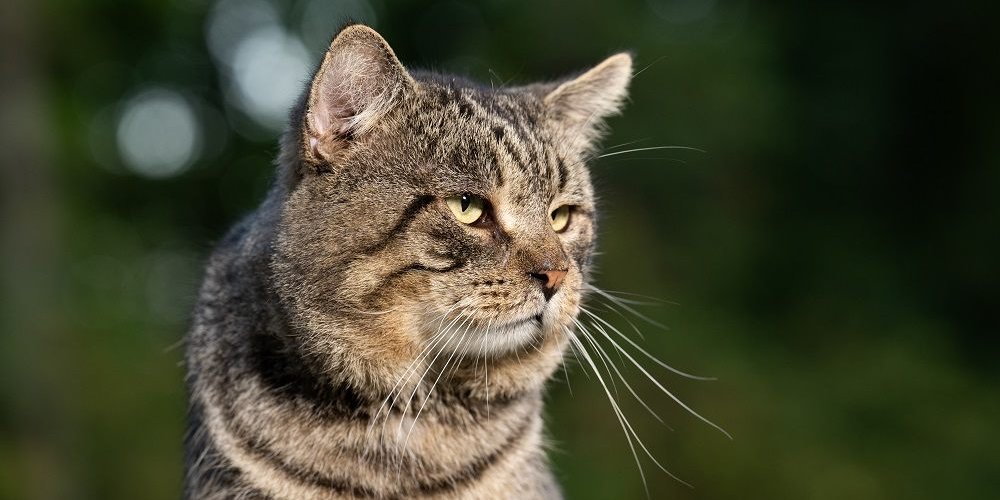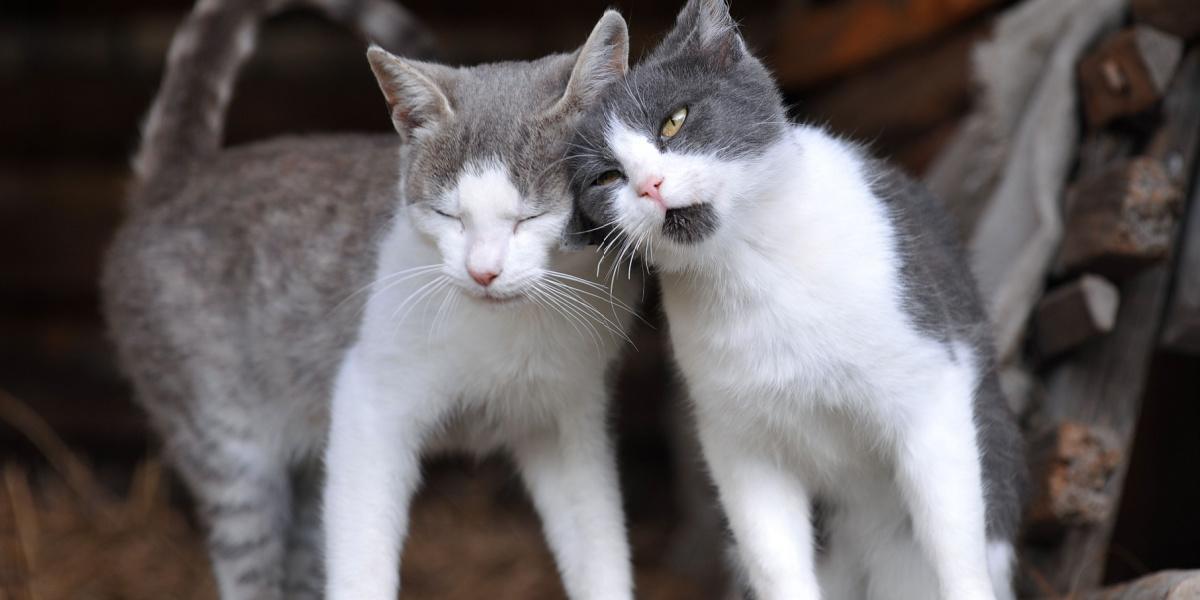Female and male cats can have some variations in look and purr-sonality. yakub88 / Shutterstock.com
Women or boys? Queens or toms? Some cat lovers choose one over the opposite, believing sure persona traits are linked to organic intercourse. Possibly you’ve heard that male cats are extra loving and feminine cats are extra impartial—or that male cats usually tend to pee round the home.
So what’s reality and what’s fiction? On this information, we’ll cowl the variations in look and persona between female and male cats.
Male Cats vs. Feminine Cats: Organic Variations

Intact male cats usually develop pronounced cheeks referred to as tomcat jowls. Tony Campbell / Shutterstock.com
Bodily variations between the 2 are current at start, akin to genitalia. It may be tough to inform the organic intercourse of a kitten when they’re first born however there are some telltale indicators to search for.
Feminine kittens’ genitals are very near the anus. The vulva seems to be like a vertical line proper under the anus, type of like an upside-down exclamation level (¡). In male kittens, there’s extra space between the anus and the genitals. This additional area is for the testicles to additional develop. The penis seems to be like one other small circle under the anus, so male genitals look a bit like a colon (:).
These variations stay by means of maturity, however an grownup male cat’s testicles are actually a lot bigger. Nonetheless, if a male cat is neutered, it may be tough to inform if he’s a male or feminine. The secret’s to have a look at the form and placement of the opening beneath the anus.
Alison Gerken, DVM, a veterinarian with the San Francisco SPCA Conduct Service explains, “Male cats have a higher distance between the anus and the genitals (about 1 inch) in comparison with females, that are about one-half inch.”
Another bodily variations between lady and boy cats embrace:
- Dimension: When in comparison with feminine cats, males are usually bigger in measurement, particularly in the event that they attain maturity earlier than neutering. This measurement distinction is extra pronounced in some breeds, such because the Maine Coon, Norwegian Forest Cat, and Ragdoll.
- Coat: Intact male cats may develop an extended, extra lush coat than feminine cats. That is significantly noticeable in some breeds during which males have a thick ruff (mane) across the neck.
- Shade: Some colour patterns are sex-linked, so feminine cats are available in some colours that male cats not often do. The calico and tortoiseshell patterns are solely seen in feminine cats. Calico is a patched tricolor sample in orange, black, and white (or the dilute variations of those colours: cream, grey, and white). Tortoiseshell is a mottled sample of swirled colour in orange and black or the dilute cream and grey). Additionally attributable to chromosomal patterns, 80% of orange cats are male.
- Face and head: Male cats that haven’t been neutered usually have greater heads and thicker skulls than feminine cats. Additionally they develop thicker whisker pads and have very giant, pronounced cheeks referred to as tomcat jowls.
- Life span: Feminine cats usually have longer life spans than male cats. The place females stay a median of 15 years, unneutered male cats have a median life span of 13 years. Nonetheless, neutered male cats stay 62% longer than intact males.
Some bodily variations between female and male cats are extra noticeable when the cats are intact (not spayed or neutered). It’s because spaying or neutering disrupts or modifications some points of organic growth, particularly within the case of early spaying and neutering.
“Male cats who’re neutered earlier than reaching sexual maturity—round 5 to 7 months of age—don’t develop hormone-related bodily modifications,” Dr. Gerken mentioned. “These cats have smaller heads and fewer muscular our bodies. They don’t develop penile barbs and so they have less-active tail scent glands—in different phrases, they aren’t as smelly!”
Male Cats vs. Feminine Cats: Character and Conduct

Genetics and youth experiences affect cats’ personalities and conduct greater than their intercourse. Margarett24 / Shutterstock.com
Dr. Gerken factors out that conduct and persona are influenced by many issues, together with genetics, atmosphere, youth experiences, diet, and sickness. Female and male cats have some normal behavioral variations, however these may solely be obvious in cats that aren’t spayed or neutered.
Among the important variations between feminine cats and male cats embrace:
1. Tendency to Roam
Intact male cats usually tend to roam additional outdoor as a result of their hormones drive them to discover a mate. Some intact male cats wander far distances and disappear for days earlier than returning residence. Spayed or not, feminine cats are a lot much less more likely to roam as far, though they might attempt to discover a mate after they’re in warmth (estrus). Neutering a male cat can considerably scale back roaming conduct.
2. Social Conduct
Pleasant interactions between cats are generally known as affiliative conduct and are supposed to develop or keep bonds. Examples embrace cats grooming one another, rubbing towards each other, or touching noses.
“Earlier analysis demonstrated that whereas each men and women interact in affiliative conduct with different cats, feminine out of doors cats exhibited affiliative conduct extra regularly than males,” Dr. Gerken mentioned. “Nonetheless, the analysis didn’t discover the intercourse of the cat to be an element that influences the frequency of affiliative conduct demonstrated between indoor cats.” In feral cat colonies, teams of females usually stay collectively, which can have influenced the frequency of those behaviors in these teams.
3. Feline Aggression
Aggression is seen in each female and male cats for a lot of causes. Nonetheless, Dr. Gerken factors out that unneutered male cats is likely to be extra more likely to exhibit aggression towards different males as they compete for territory or mating alternatives. In some instances, spaying or neutering the cat can lower aggression.
4. Warmth Cycle Behaviors
Feminine cats that aren’t spayed usually show very particular behavioral modifications throughout a warmth cycle. Feminine cats in warmth are more likely to cuddle and be extra affectionate, purr and vocalize excessively, appear stressed, roll round on the ground, and groom excessively. Spaying feminine cats eliminates behaviors related to going into warmth.
5. Urine Spraying and Marking
You is likely to be shocked to study that intact cats of both intercourse can routinely urine spray. This regular cat conduct is a type of communication, marking territory and attracting mates. Urine spraying could be decreased or eradicated by spaying or neutering the cat.
Nonetheless, even some spayed and neutered cats interact in urine marking. Analysis has proven that about 10% of neutered male cats and 5% of spayed feminine cats proceed to spray into maturity, no matter what age they had been spayed or neutered.
“That is doubtless as a result of different motivations, except for the territorial and sexual connotations, exist for urine spraying,” Dr. Gerken mentioned. Cats may spray in response to emphasize, shifting to a brand new residence, modifications of their routine, an insufficient litter field setup, or due to a bodily illness.
6. Shade-Linked Character Traits
Some individuals suppose tortoiseshell cats exhibit spicy and sassy attitudes, one thing that even has its personal title: tortitude. Many cat lovers imagine calico cats are simply as feisty and that orange cats are the friendliest. However are these perceptions actual or only a fantasy?
Analysis on this space is restricted. One pet proprietor research discovered that calico and tortoiseshell cats had been extra more likely to present behaviors like hissing, chasing, biting, swatting, or scratching when interacting with people.
Nonetheless, Dr. Gerken recommends taking these findings with a grain of salt since they had been based mostly on the subjective opinions of the cats’ homeowners. “Preconceptions about color-linked persona traits could have prompted the homeowners to note and report these traits of their cats,” Dr. Gerken mentioned. “Every cat is a person with their very own distinctive persona no matter coat colour.”
About Us web page to find out about our requirements and meet our veterinary overview board.
-
https://journals.sagepub.com/doi/10.1177/1098612X14536176
-
https://www.avma.org/javma-news/2013-07-01/banfield-spaying-neutering-correlate-longer-lives
-
https://www.sciencedirect.com/science/article/abs/pii/S0168159199000301#:~:textual content=Therepercent20arepercent20reportspercent20thatpercent20describe,behaviorpercent20morepercent20frequentlypercent20thanpercent20males.
-
https://www.ncbi.nlm.nih.gov/pmc/articles/PMC3078130/
-
https://theaggie.org/2016/01/20/uc-davis-study-finds-calico-tortoiseshell-cats-to-be-most-aggressive/#:~:textual content=Theypercent20usedpercent20apercent20scalepercent20from,exhibitpercent20morepercent20signspercent20ofpercent20aggression.

